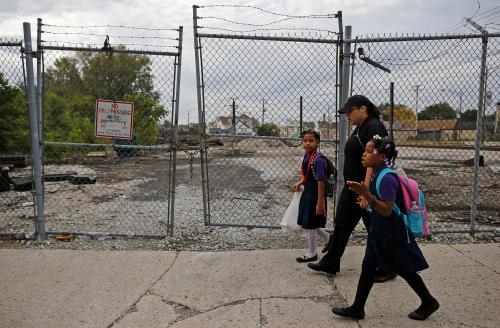Each month, the Bureau of Labor Statistics releases its Employment Situation report (better known as the “jobs report”) to outline the latest state of the nation’s economy. And with it, of late, have been plenty of positive headlines—with unemployment hovering around 3.5%, a decade of job growth, and recent upticks in wages, the report’s numbers have mostly been good news.
But those numbers don’t tell the whole story. Are these jobs any good? How much do they pay? Do workers make enough to live on?
Here, the story is less rosy.
In a recent analysis, we found that 53 million workers ages 18 to 64—or 44% of all workers—earn barely enough to live on. Their median earnings are $10.22 per hour, and about $18,000 per year. These low-wage workers are concentrated in a relatively small number of occupations, including retail sales, cooks, food and beverage servers, janitors and housekeepers, personal care and service workers (such as child care workers and patient care assistants), and various administrative positions.
Just how concerning are these figures? Some will say that not all low-wage workers are in dire economic straits or reliant on their earnings to support themselves, and that’s true. But as the following data points show, it would be a mistake to assume that most low-wage workers are young people just getting started, or students, or secondary earners, or otherwise financially secure:
- Two-thirds (64%) of low-wage workers are in their prime working years of 25 to 54.
- More than half (57%) work full-time year-round, the customary schedule for employment intended to provide financial security.
- About half (51%) are primary earners or contribute substantially to family living expenses.
- Thirty-seven percent have children. Of this group, 23% live below the federal poverty line.
- Less than half (45%) of low-wage workers ages 18 to 24 are in school or already have a college degree.
These statistics tell an important story: Millions of hardworking American adults struggle to eke out a living and support their families on very low wages.
What should be done? Some suggest that education and “upskilling” is the answer, arguing that if these workers got more education and increased their skills, they would move up to higher-paying jobs.
That is partially true. The majority of low-wage workers (77%) have less than a college degree, and we would never bet against education. Increasing the quality and accessibility of skill-building opportunities is an excellent goal, and part—but certainly not all—of the solution. We need additional funds, a commitment to change the status quo, toward more student- and worker-centric models.
These statistics tell an important story: Millions of hardworking American adults struggle to eke out a living and support their families on very low wages.
However, imagine that everyone without a college degree suddenly earned one. The jobs that pay low wages would not disappear. Hospitals would still need nursing assistants, hotels would need housekeepers, day care centers would need child care workers, and so on.
We need to think not only about workers, but about the work they are doing. What kinds of jobs are we generating, do they pay enough to live on, and to whom are they available?
Other research from Brookings Metro and the Federal Reserve suggests that there are not enough decent-paying jobs for people without bachelor’s degrees. This matters—workers without bachelor’s degrees make up not just the majority of the low-wage workforce but the majority of the labor force as a whole, so the shortage of such jobs has wide-ranging consequences.
Even with sunny job statistics, the nation’s economy is simply not working well for tens of millions of people.
Labor market conditions are not acts of God, nor inevitable. They are shaped by policies, investments, and institutions. As we grapple with structural changes in the economy—globalization, the effects of technology, the shift from production to services, declining union membership, the fissuring of the workplace, increased concentration of market power—we need to remember that the rules of the game are not set in stone.
We should look at individuals—not national averages—as the unit of analysis, and ask: Are wages adequate? Can people support themselves and their families if they work full time?
Currently, the answer is “no” for a distressingly large share of the workforce. This is not controversial or disputed. There are a variety of indices—the United Way’s ALICE threshold, MIT’s living wage calculator, the Self-Sufficiency Standard, and EPI’s Family Budget Calculator—that show basic costs of living (housing, food, child care, transportation, health care, taxes) frequently outpacing earnings from low-wage jobs, even in families with more than one worker.
Looking at the broader economic picture, taxation expert Edward Kleinbard offers a useful formulation: Are markets friendly to workers and serving society’s best interests, or are they a hostile force? Wages for most workers (except those at the top) have stagnated or declined in recent decades, even as costs for basic inputs to a stable life—such as health care, housing, and education—have skyrocketed. Market failures abound: Education and health care are out of reach for many, child care is often prohibitively expensive (even as child care workers are woefully underpaid), and decent, affordable housing is scarce in many regions. If society’s best interests are served by having people employed, housed, educated, and healthy, then we need to rethink the fundamentals of our economic and social policies.
We should look at individuals—not national averages—as the unit of analysis, and ask: Are wages adequate? Can people support themselves and their families if they work full time?
Federal, state, and local governments can take a number of steps to improve workers’ economic security. Boosting wages through tax credits, a higher minimum wage, or supporting sectoral bargaining; supporting families with high-quality child care; and giving workers more control over their time via stable scheduling are just a few options.
The monthly jobs report provides critical information on the state of the economy. But too often, we focus only on toplines and trends, when we need to keep our eye on baseline employment conditions. As economist Jared Bernstein noted, we must focus not just on wage trends but on wage levels. Economist Heather Boushey, too, wrote that we should move beyond the averages—which can mask many disparities—and look at how people at all levels of the earnings and income spectrum are faring.
Regardless of whether the unemployment rate tics up or down, let’s keep the following numbers front and center in discussions on workers and the economy: 53 million people earn low wages, with a median of just $10.22 per hour. That’s nearly half of the 18 to 64 workforce. If we don’t face the reality of the labor market, we can’t make it better.
The Brookings Institution is committed to quality, independence, and impact.
We are supported by a diverse array of funders. In line with our values and policies, each Brookings publication represents the sole views of its author(s).








Commentary
Low unemployment isn’t worth much if the jobs barely pay
January 8, 2020